All you need to know about Masai's Full-Stack Developer Course
Owing to the well-structured full-stack developer course, top tech companies like Ola, Swiggy, ShareChat, Freshworks, Dream11, etc. hire Masai grads, offering high packages up to as much as 24 LPA.

India is going through an explosive growth phase in IT (information technologies) and especially the software sector.
With this growth, arises the need for software developers in the country.
However, a shocking piece of data from the Aspiring Mind survey suggests that 95% of engineers in the country are not fit for software development roles. (Source- Business Insider).
Robert Baptiste, a french hacker who once challenged Aadhar’s security had this to say about Indian developers-
“I used to work with Indian developers and sometimes it’s very painful. Seriously, you are a senior developer and you don’t know how to use Git? You are a backend developer and you don’t know how to do a curl request?”
There are a number of reasons for this. From the outdated syllabus in colleges to the lack of practical implementation, Indian students are unable to develop the skills required for the fast-moving industry.
Introducing Masai’s Full-stack Web Development Course
Keeping this problem statement in mind, Masai School started the full-stack developer course to train students into becoming professional-level developers. To make it easily accessible for every student out there, the program has a ‘pay after placement’ setup. This means, they only need to pay once they’re placed at a salary of 5 LPA or more. (PAP)
Because of the primary focus being on skill development (and not just passing marks), our grads have been able to crack software developer roles at top tech companies in India, including the likes of Ola, Swiggy, Dream11, ShareChat, etc.
So, if you’re willing to build a scalable career in the tech industry, you’ve arrived at just the right place. In this article, you’ll know what makes Masai’s full-stack developer course different, and how you can be a web developer in 7 months and bag a handsome package.
Table of Contents:
- MERN Stack
- Front-end Components
- Back-end Components
- Data Structures & Algorithms
- Masai School Accreditation
- Masai School Placements
First, let’s start with understanding- What is a full-stack developer?
What makes a Full-stack developer?
Full-stack developers are people who can work on all the branches of a web application including databases, servers, and clients. They have the ability to create a website from start to finish as well as maintain its functionality.
But what exactly do they do?
Full-stack developers operate two different domains of web development- front-end development & back-end development. Both of these domains work together to bring the technology to life for end-users.
What is Full-stack?
By full-stack, we mean the collection of a series of technologies required to complete a certain project.
For example, let’s take Masai School’s website – All visible elements on the web page – The icons, the text size, font style, choice of colours, & positioning of elements constitute the front-end of the website.
Front-end development is concerned with the user side of the web application that a site viewer can see and interact with.
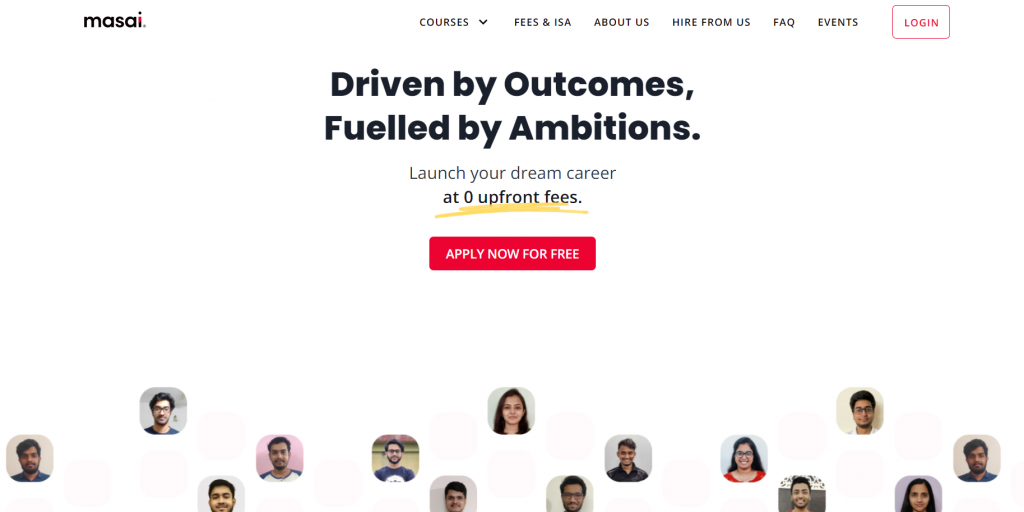
Let’s take another example – The sign-up form. What you see in terms of input fields, buttons – All of it is the front-end, i.e users can see and interact with it, but once the user enters their credentials – Email, Password – The Back-end takes over, and for the user to successfully login, it validates the user information with the password stored in the database.
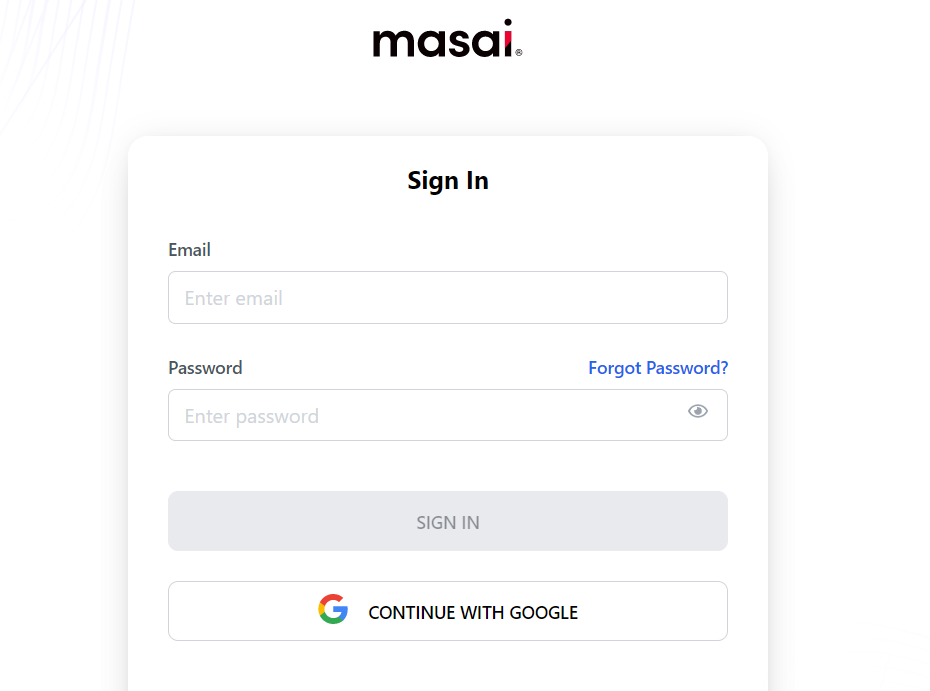
The back-end of a web application is built up with a server (for hosting), a database (for storage), and an application (for functionality).
The coming together of front-end, and back-end to create a seamless website experience is what constitutes full-stack, and developers who can dabble with both ends to get the output are called full-stack developers.
What do you learn in Masai’s Full-stack Developer course?
Masai’s curriculum focuses on building up the fundamentals of programming in students, along with training them on the latest technologies and tools that are in demand currently.
The result – we get highly competent developers who are ready to work in top companies from the get-go.
The course is based on the MERN stack, one of the most important tech stacks in the industry today.
What is the MERN stack?
Think of the different building materials we can use to build a house – concrete, wood, or clay. Similarly, we use different tech stacks to build software depending on our requirements.
MERN stack is one such technology. It is a JavaScript-based stack used for faster deployment of web applications. (Click to know the most popular tech stacks)
MERN is made up of four technologies: MongoDB, Express.js, React.js, and Node.js.
Today, top brands are operating on the MERN stack such as the likes of Instagram, UberEats, and Walmart, among others.
Let’s now understand the different components you’re going to learn for development on the MERN stack-
Front-end Components
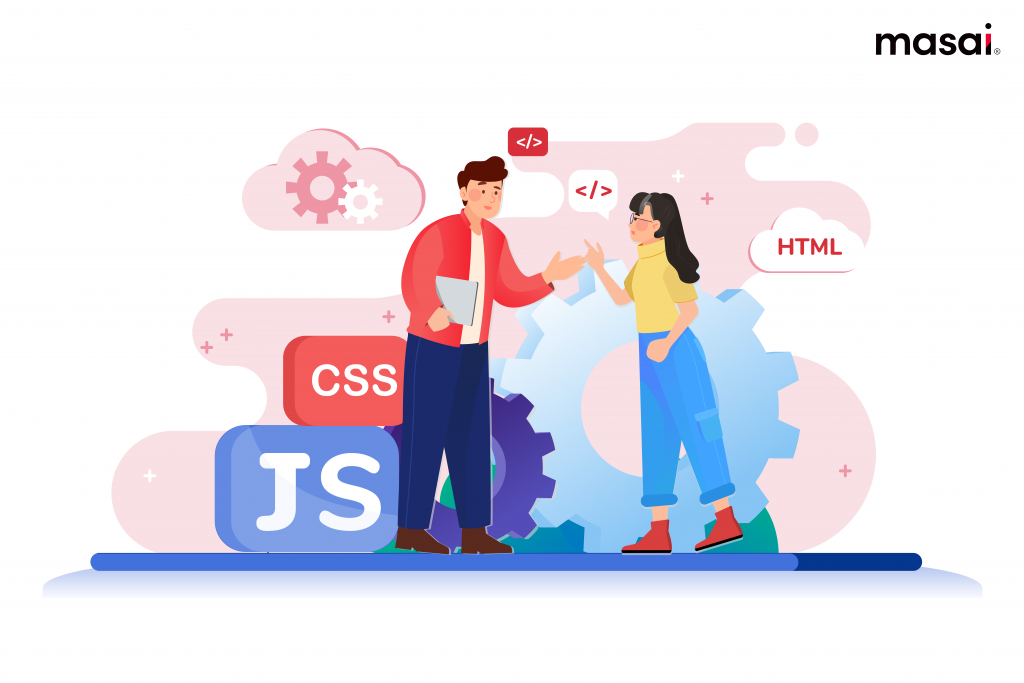
HTML and CSS
HTML stands for HyperText Markup Language.
Here, Hypertext means text that’s clickable, while Markup language means to indicate things.
HTML is the foundation stone behind everything that is viewable on the web browser. It represents the whole structure of a webpage.
Every page we visit from social networks to blogs has a set of HTML tags and a hyperlink that connects it to other pages.
Note- Right-click anywhere on this page and view the page source, you’ll see the code written in HTML. This code is used to position the text, images, frames, and other elements on the webpage.
In the full-stack web development course at Masai, you’ll cover the following topics in HTML-
- HTML overview
- HTML & Browsers
- Tags, attributes and elements
- Web Page structure (headings, paragraphs, and formatting text)
- Images and tables
CSS expands to Cascading Style Sheets. CSS defines the text colour, font, column size, layout designs among other elements on the webpage.
It is used in addition to HTML to make the website presentable.
How?
Imagine entering the HTML tags for font, colour, etc. on every page of a website. CSS solves this problem by applying a single tag to all of its occurrences on the website.
Especially in bigger websites, the role of CSS is paramount as it-
- Saves time
- Provides more attributes
- Makes website maintenance easier
- Helps pages load faster
In order to become a professional developer, one must be proficient in both HTML and CSS.
JavaScript
The two most used tech stacks – MEAN and MERN are based on JavaScript, end-to-end.
Besides, it is the third major component in front-end development after HTML and CSS. It makes the web application interactive for the user.
For example- Website forms, pop-ups, and dropdowns on a webpage are usually written using JavaScript.
In other words, it adds behaviour to the webpage.
It comes with code libraries and frameworks including React, React Native, Angular, etc which make a developer’s job easier, providing them with pre-written code components.
In the full-stack web development course at Masai, you’ll get to learn all these frameworks and tools that are the cogs in the wheel of software development.
React
Once you’re familiar with the basics of HTML, CSS, and JavaScript, it’s time to get into React.
It is a front-end JavaScript library used to create dynamic User interfaces (UIs).
React is used widely due to its efficiency and flexibility. It allows developers to create simpler, reusable UI components, so they can add these components to build complex UIs.
React is mainly concerned with building the View Layer of an application. It enables developers to build large applications where we can change data without reloading the page. (Know more about React)
With that being said, let’s look at the topics you’ll cover in React-
- React and React ecosystem
- UI libraries and reusable components
- Redux and hooks
Back-end Components in Full-stack Developer Course
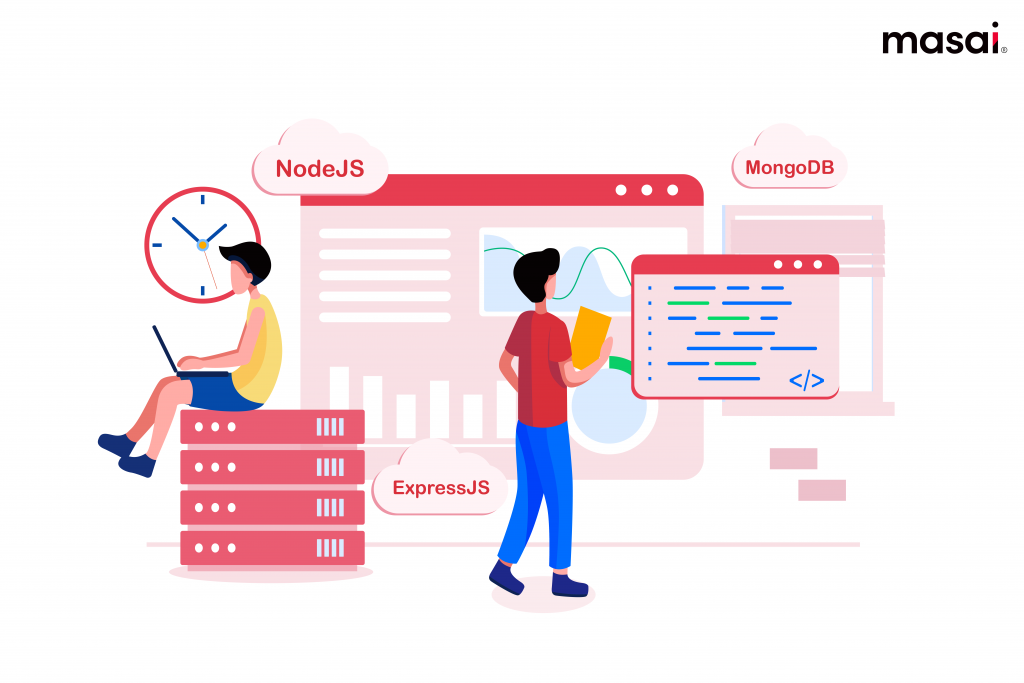
Node.js
Node.js is a server-side run-time environment that acts as a back-end platform.
It is open-source and is compatible with various platforms like Windows, Linux, Unix, Mac OS, etc.
Today, most companies choose Node.js because of its speed and scalability.
So, a developer needs to have a good understanding of JavaScript, and specifically Node.js to build diverse, efficient, and cost-effective solutions. (Learn more about Node.js)
Following are a few niche/examples where Node.js is the perfect fit-
- Streaming services
- Online games
- Single-page applications
- Chat networks
In the full-stack developer course at Masai, you’ll learn-
- Node.js – Basics and setup
- Node.js Concepts
- Command utilities
- Node.js Console
- Node.js with Express.js
- Database access
Express.js
Express.js is an open-source framework that is based on Node.js’s web server.
It is used for building web applications quickly using the principles of Node.js.
Along with providing a simple routing for clients’ requests, Express.js provides a middleware that makes decisions to give the correct responses to a user’s request.
It’s an easy-to-use framework as it only requires JavaScript. It also provides a debugging mechanism that can trace the exact location of the bugs in a web application.
The ease of coding in Express.js coupled with Node.js’s powerful performance makes them a perfect combination for the developers.
MongoDB
MongoDB is the preferred database by companies and developers when it comes to storing huge volumes of data with high performance. Since it’s a NoSQL database i.e. unstructured data, it has a high processing speed.
Here are a few use cases of MongoDB-
- E-commerce/product based applications
- High-speed logging and caching in real-time
- Maintenance of location wise Geospatial data
- Blog and CMS (Content Management systems)
MongoDB’s syntax is easier to learn due to its similarity with JavaScript.
In the 4th unit of the full-stack developer course, you’ll learn-
- SQL and NoSQL
- Setting up and managing MongoDB
- Migration of data into MongoDB
- MongoDB with Node.js
- MongoDB services
Till now, we have covered the different programming languages, servers, and databases we need to develop a web application. Let’s now shift our attention to the most fundamental aspects of programming i.e. data structures and algorithms.
Data Structures & Algorithms
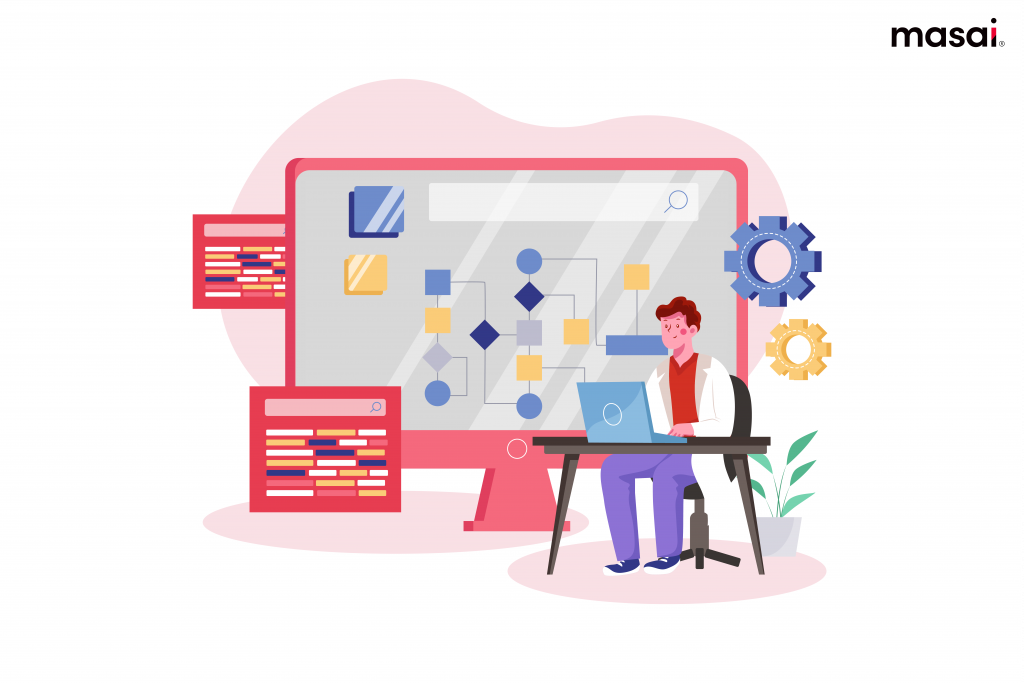
DSA is the root and stem of programming.
Structures refer to the containers we use to store data in a specified format. While algorithms are the methods we implement in order to solve a given problem statement.
Why do students need DSA?
DSA makes one a better thinker and thus a better programmer. It improves one’s problem-solving ability by focussing on the logic behind those problems.
Surely as a coder, you can translate the given logic into machine code. But to analyze, and conceptualize the problem and build optimal solutions, DSA is a must.
It is the core concept in development meaning, it is independent of the changes in the tech stacks. DSA stays the same no matter what tech stack is being used.
That’s why tech giants like FAANG companies(Facebook, Amazon, Apple, Netflix, and Google), and emerging tech startups need people who are skilled in DSA so they can adapt to new frameworks quickly.
However, most students in India avoid learning DSA as they find it difficult compared to the development side, and they often think it’s not important for a job. This mistake hurts their career prospects, and they don’t experience the same growth as someone with proficiency in data structures and algorithms. (Beginner’s guide to DSA)
And that’s precisely why we have DSA in our full-stack developer course syllabus. Students receive training in multiple data structures and algorithms throughout the 6 units, some of which include-
- Primitive and abstract data types
- Arrays
- Stacks and Queues
- Bubble and selection sort
- Recursion and backtracking
- Binary search, Dynamic programming
- Graph theory
Additionally, students get a number of DSA problems every day to increase their conceptual understanding and logical & imaginative thinking.
Noone can be called a full-stack developer in the true sense without having a stronghold on DSA, period.
Professionalism / Job Skills
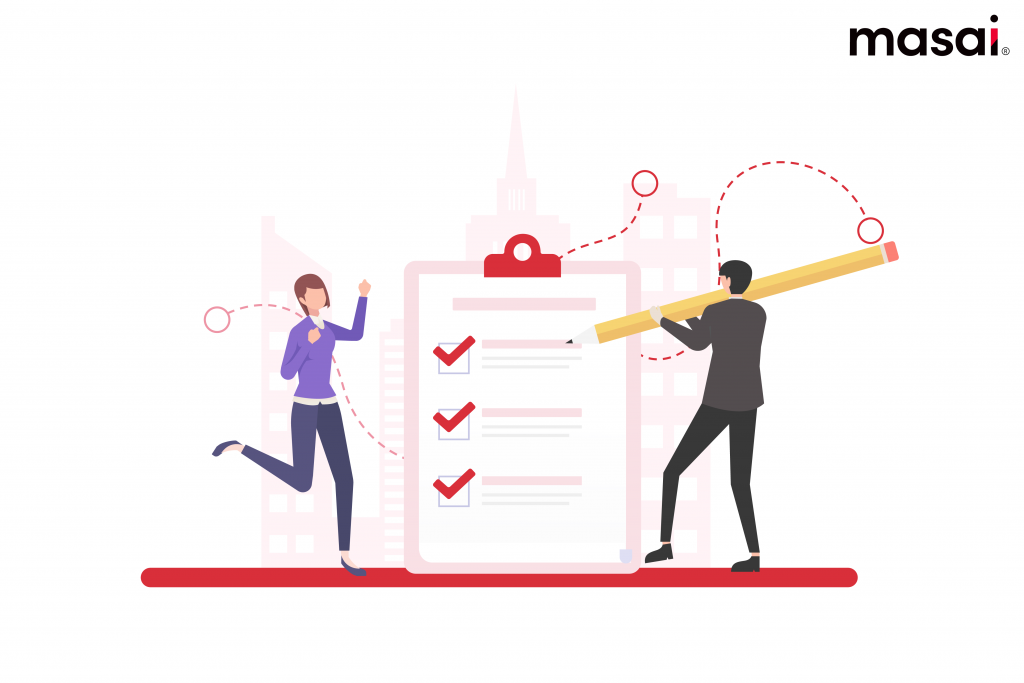
The technical skills that we discussed above are not the only skills students acquire at Masai. A big part of their candidature involves professional/job skills.
And why wouldn’t that be?
In today’s fast-paced and collaborative workplaces, companies need people who exude professionalism, people who have communication and networking skills, and who can work efficiently in team-based environments.
All these requirements are taken care of with utmost detail at Masai in the process of crafting students into industry-ready professionals.
Every day, Skillathon sessions at Masai focus on building employability skills in freshers. They learn new ways and methods to improve their communication, be more confident, and develop a growth mindset.
Resume/portfolio building
Once a student completes their coursework, they have to finish off a checklist which includes-
- Resume
- Github Profile
- Attendance (should be greater than 90%)
- Assignment completion
- Portfolio and artifacts for the student’s track
- One on one behavioural interview
Masai School Accreditation
Accreditation is the official and final approval given by Masai School when a student becomes skilled and ready to start their career as a developer. It is the gateway for students to sit for placements, and also a signal to companies that a particular student is ready to work.
How does a student achieve accreditation?
Under MAC, students go through a full-stack web interview where they’re asked to present the projects they’ve built to industry mentors. This is a live interview which gives them a heads up for the actual interviews they’d be facing.
Students demonstrate qualities like team contribution, learning aptitude, communication, etc.
Towards the end, students take part in a coding tournament that consists of 2-3 DSA problems followed by a live code challenge.
Only after ticking all these boxes, does a student receive graduation from Masai and is considered ready to sit for the placements. (Know more about MAC)
Masai School Placements
After the students have spent more than 1000 hours coding and learning other skills, it’s time to bear the fruits of their hard work, and bag high-paying jobs in the software industry.
The placement process starts with-
- Placement Orientation – The Masai team shares with the students a list of companies that are onboarded in the hiring process. It takes place 10-14 days before graduation.
- Placement Kickstart – At this stage, companies start shortlisting students and scheduling interviews with them. Our placement team is in constant touch with both hiring partners and students to ensure seamless communication.
- Offer acceptance – Once a student has cleared the interview for a company, our team verifies the offer letter and makes sure the company’s offering is in line with Masai standards.
Students receive the offer letter and are on their way to work as professional developers/engineers.
Is there a demand for Full-stack developers?
Having vast experience across all stacks/layers of web development, the demand for full-stack developers has definitely been soaring.
According to LinkedIn’s 2020 Top Emerging jobs report, full-stack engineers were ranked number 4 on the list. Big companies and startups alike need people who are proficient in all the branches of web development.
In hiring a full stack developer, the companies get –
- A jack of all trades who understands the entire operation from its roots.
- Someone who understands the systems and processes at a master level and who can adapt quickly as the technologies and tasks evolve with emerging AI applications.
- Someone who can communicate with the UI/UX designers in their language and bring out the best results.
Because of these qualities, the companies are prioritizing full-stack developers today all across the globe.
And India is not far behind either. With a rapid tech evolution, the country is in a dire need of full-stack developers. And, this void needs to be filled.
Owing to the well-structured full-stack developer course, top tech companies like Ola, Swiggy, ShareChat, Freshworks, Dream11, etc. hire Masai grads, offering high packages up to as much as 24 LPA. (Know 11 unicorn startups that hire from Masai)
Is Masai the right place for you?
Full-stack courses are not rare. In fact, you can find thousands of them on the internet.
But, providing aspiring developers with structured learning, real-time projects, guided mentoring, and most importantly outcome-based education are the attributes that Masai focuses on.
Want to be a full-stack developer but not sure where and how to start?
Or do you come from a non-tech background, and you’re willing to switch careers and work in high-earning roles in the software industry?
Start off by checking out these full-time and part-time courses in web development and android development.
Apply at zero upfront fee and see your life transform in 7 months’ time.
Take action!

